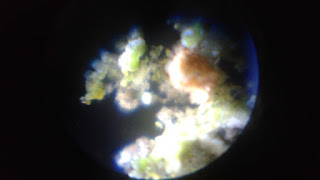


Because you never know when opportunity will strike...
The unusually warm weather of this December and the purchase of a home microscope have made me ambitious, scraping trees of moss and lichen, looking for tardigrades. I first used the microscope kit's rather dull scalpel and a bill envelope to collect samples from the large oak on my property, as well as some off a pine in the woods nearby. But when I took my daughter to Fargnoli Park December 26th (it was in the 50s), I realized I was potentially missing an opportunity.
I had travelled light, wearing only a sweater and cargo pants, none of my usual tools I stuff in my pockets on me. Yet, here was an expired coupon I had been using as a bookmark in my Game of Thrones book and here on my key chain was one of several store cards that get scanned on my trips there. I folded up the coupon to make a crude envelope as I walked passed several sycamore trees. Gently I scraped the soft yellow-green lichen and pulled out an elusive piece of moss from inside the grooved bark of an enormous oak tree.
The bit of moss was the 3rd one I tried for, after dropping the first two into oblivion. I tucked the envelope into my right front pocket and my daughter and I continued our play on the swings and see-saw. Back at home, I removed the folded paper and placed it on a book shelf. Later, I used the lid of the petri dish (the base was already occupied with yard samples) to add bottled water for it to sit in overnight. Tardigrades and many other microscopic animals are aquatic.
To best view my finds, I used the method recommended by Mike Shaw:

I took a lot of blurry photos with my cellphone shaking over the microscope viewer. I will work on a better system. But for now, I thought I'd share some of my findings:
 |
| Early photo of moss from ground. No critters I could see. |
 |
| Thought the white image in center was a tardigrade. Adjusted focus and lighting and as it never moved, decided it was part of the moss. |
 |
| First images of moving creatures. Have since identified as a rotifer. |
 |
| Two creatures continue to move, standing up and swaying. |
 |
| One on right goes behind moss briefly, then reappears. |
Still not sure what I found. Any answers out there? Looking up rotifers now...
Edit: It WAS rotifers!! Hoping to get better pictures next time. Keep exploring!
More pictures and video below:
 |
| Base of seed from sycamore seed ball. |
Something speedy...
Rotifer moving about petri dish.
Nematode doing the whip and nae nae:
























![Datura seeds and seed pod, [ Angel Trumpet, Loco Weed]:](https://s-media-cache-ak0.pinimg.com/736x/f3/8e/9e/f38e9e3f0fcf3d541450642bcb9408b1.jpg)
















